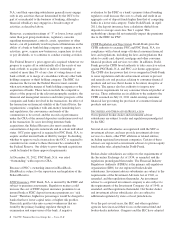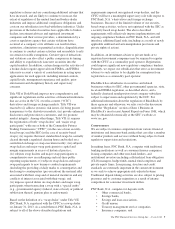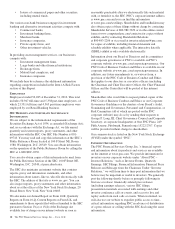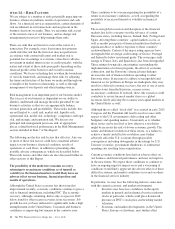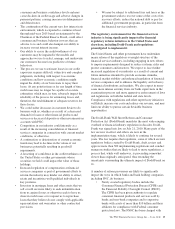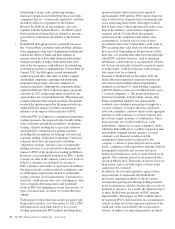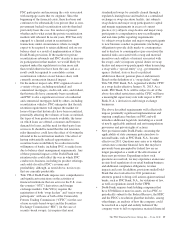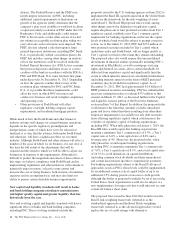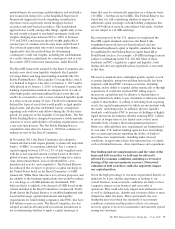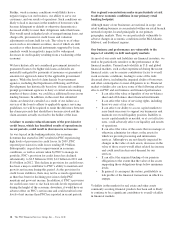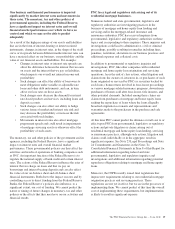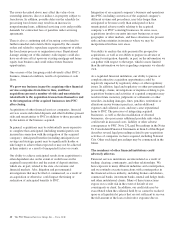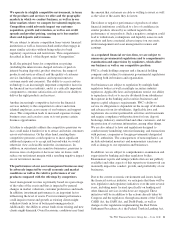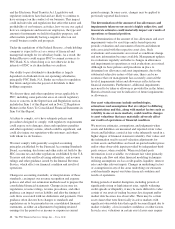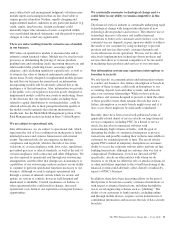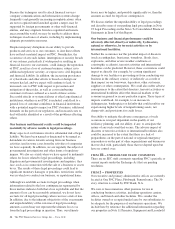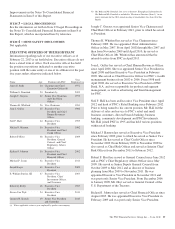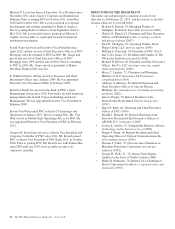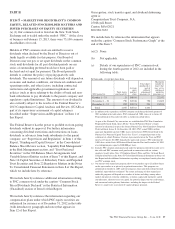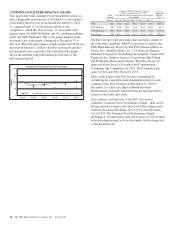PNC Bank 2012 Annual Report Download - page 37
Download and view the complete annual report
Please find page 37 of the 2012 PNC Bank annual report below. You can navigate through the pages in the report by either clicking on the pages listed below, or by using the keyword search tool below to find specific information within the annual report.Further, weak economic conditions would likely have a
negative impact on our business, our ability to serve our
customers, and our results of operations. Such conditions are
likely to lead to increases in the number of borrowers who
become delinquent or default or otherwise demonstrate a
decreased ability to meet their obligations under their loans.
This would result in higher levels of nonperforming loans, net
charge-offs, provision for credit losses and valuation
adjustments on loans held for sale. The value to us of other
assets such as investment securities, most of which are debt
securities or other financial instruments supported by loans,
similarly would be negatively impacted by widespread
decreases in credit quality resulting from a weakening of the
economy.
We have historically not considered government insured or
guaranteed loans to be higher risk loans as defaults are
materially mitigated by payments of insurance or guaranteed
amounts for approved claims by the applicable government
agency. While the level of claim denials by government
agencies, including the Department of Housing and Urban
Development, has historically been low, if financial conditions
prompt government agencies to deny or curtail an increasing
number of these claims, we could face additional losses in our
lending business. In addition, in the event that submitted
claims are denied or curtailed as a result of our failure as a
servicer of the loan to adhere to applicable agency servicing
guidelines, we will be required to remit the difference between
the claims proceeds that should have been received and the
claim amounts actually received to the holder of the loan.
A failure to sustain reduced amounts of the provision for
credit losses, which has benefitted results of operations in
recent periods, could result in decreases in net income.
As was typical in the banking industry, the economic
downturn that started in 2007 resulted in PNC experiencing
high levels of provision for credit losses. In 2009, PNC
reported provision for credit losses totaling $3.9 billion.
Subsequently, in part due to improvement in economic
conditions, as well as actions taken by PNC to manage its
portfolio, PNC’s provision for credit losses has declined
substantially, to $2.5 billion in 2010, $1.2 billion in 2011 and
$1.0 billion in 2012. This decline in provision for credit losses
has been a major contributor to PNC’s ability to maintain and
grow its net income during this period. As the provision for
credit losses stabilizes, there may not be as much opportunity
as there has been for declining provision to help PNC
maintain and grow net income. In addition, if PNC’s provision
for credit losses were to rise back towards levels experienced
during the height of the economic downturn, it would have an
adverse effect on PNC’s net income and could result in lower
levels of net income than PNC has reported in recent periods.
Our regional concentrations make us particularly at risk
to adverse economic conditions in our primary retail
banking footprint.
Although many of our businesses are national in scope, our
retail banking business is concentrated within our retail branch
network footprint, located principally in our primary
geographic markets. Thus, we are particularly vulnerable to
adverse changes in economic conditions in the Mid-Atlantic,
Midwest, and Southeast regions.
Our business and performance are vulnerable to the
impact of volatility in debt and equity markets.
As most of our assets and liabilities are financial in nature, we
tend to be particularly sensitive to the performance of the
financial markets. Turmoil and volatility in U.S. and global
financial markets, such as that experienced during the recent
financial crisis, can be a major contributory factor to overall
weak economic conditions, leading to some of the risks
discussed above, including the impaired ability of borrowers
and other counterparties to meet obligations to us. Financial
market volatility also can have some of the following adverse
effects on PNC and our business and financial performance.
• It can affect the value or liquidity of our on-balance
sheet and off-balance sheet financial instruments.
• It can affect the value of servicing rights, including
those we carry at fair value.
• It can affect our ability to access capital markets to
raise funds necessary to support our businesses and
maintain our overall liquidity position. Inability to
access capital markets as needed, or at cost effective
rates, could adversely affect our liquidity and results
of operations.
• It can affect the value of the assets that we manage or
otherwise administer for others or the assets for
which we provide processing and information
services. Although we are not directly impacted by
changes in the value of such assets, decreases in the
value of those assets would affect related fee income
and could result in decreased demand for our
services.
• It can affect the required funding of our pension
obligations to the extent that the value of the assets
supporting those obligations drops below minimum
levels.
• In general, it can impact the nature, profitability or
risk profile of the financial transactions in which we
engage.
Volatility in the markets for real estate and other assets
commonly securing financial products has been and is likely
to continue to be a significant contributor to overall volatility
in financial markets.
18 The PNC Financial Services Group, Inc. – Form 10-K


